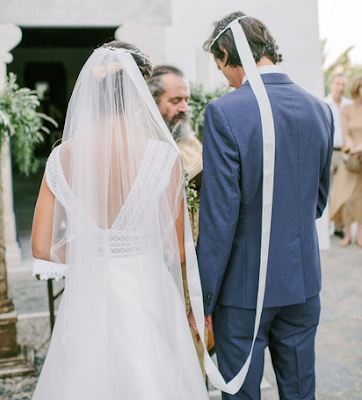Delving into the history of wedding rings leads to ancient cultures with rings crafted of similar materials but symbolizing different meanings. Where did the
wedding ring custom get its start? Like many ancient customs it is not
something agreed upon even by historians. In my research, I give that nod of
the head toward the ancient Egyptians, but some suggest it goes back all the way to the
Neanderthals.
Wedding ring customs through the centuries
Marriage existed throughout ancient cultures around the
world. And from this tradition came the custom of wedding rings. The look of wedding rings has changed throughout the centuries. Earliest rings
were crafted of leather, ivory or bone. While the materials used were similar among early cultures, it's interesting to note that what wedding rings represented differed from one culture to another.
Ancient Egyptian wedding rings
The origin of wedding rings isn’t one hundred percent certain, but based
on archeological evidence dating back 3000 years, most historians agree that ancient
Egypt was the first culture to exchange wedding rings. These rings were intricately
crafted into beautiful jewelry from braided reeds and hemp and placed on the
fourth finger as a symbol of the love. However, the ring exchange was not part
of a public wedding ceremony but took place in private with rings presented as gifts. Historians have determined through hieroglyphics that the
shape of the ring, the circle, symbolized eternal life and the opening in the
center was thought to be a portal to a future between two newlyweds.
Ancient Roman wedding rings
Marriages in ancient
Rome had to conform to Roman law and were categorized by social class. This
included three different categories of weddings: Usus, Coemptio, and
Confarreatio. For the lowest class, the word for marriage was Usus.
Today, we can compare it to a common-law marriage. For the next class up, marriage
was known as the Coemptio and involved purchasing the bride. In this case, not
all historians agree on whether this was an actual purchase or a symbolic sale,
but either way, the ring represented a purchase. However, neither of these marriages
were considered legal.

The only authorized marriage in Ancient Rome was the Confarreatio, a privilege reserved for
the elite upper class. These marriages were presided over and the groom
presented his bride with a ring during the ceremony. The wedding ring tradition began with
rings made of flint and bone. Later rings were crafted of copper, silver, and
gold. Most Confarreatio rings were crafted of iron or
gold with the iron ring worn in private and the gold ring worn in public. Even in these upper-class
marriages, the rings were not considered symbols of love but rather symbols of
possession—that the wife belonged to the husband. However, in the brides favor,
it also meant that the married woman had a right to her husband’s possessions.
Ancient Greek wedding rings
The first Ancient
Greek wedding rings were also crafted of leather, ivory or bone, but when metal
rings were introduced, a simple gold band was worn on the left hand as an engagement
ring and was then moved to the right hand when married. Later gold rings inlaid
with colorful gems, crystals, or glass became popular. These precious rings were often passed from one
generation to the next becoming the first heirloom rings.
Indian wedding rings
Historically, in Ancient India, according to Manu Smiriti, the laws of Manu
or Manava Dharma Shastra, eight main forms of Hindu marriages existed in
ancient India. I will create another post to explain that in detail at
another time. In ancient India, gold was the most idolized form of jewelry. This
love of gold jewelry even extended to dressing animals, like elephants, in
intricate gem-studded pieces. It is thought that this love for jewelry stemmed
from the culture’s belief in mystical qualities thought to protect the wearer from
evil. Traditional Indian brides wore the wedding ring on the right hand because
the left hand is considered unclean.
A couple of other things worth mentioning include the Nath, also commonly
known as the nose stud or Indian bridal nose ring. Ancient Indian brides (and brides
today) wore this bridal nose ring with a long chain of gold connected to the
ear. This is not a wedding ring but is part of the bride’s ensemble.
*
* *
Some links in this
post are affiliate links. We are a participant in the Amazon Services LLC
Associates Program, an affiliate advertising program designed to provide a
means for us to earn fees by linking to amazon.com and affiliate sites.
Photo credits: pixnio.com














